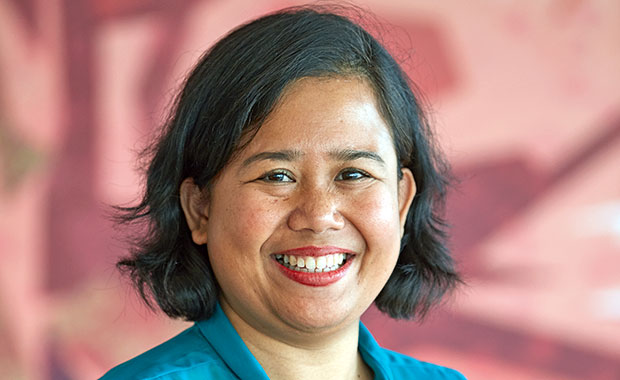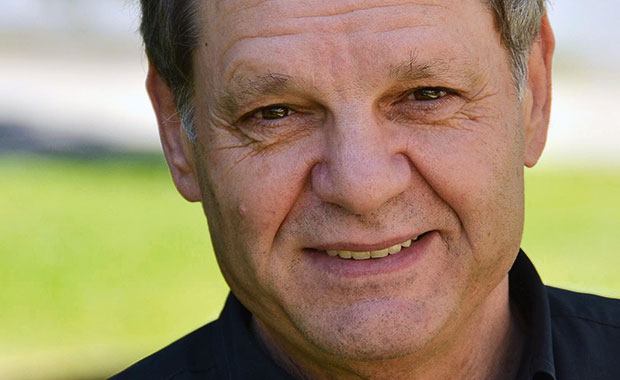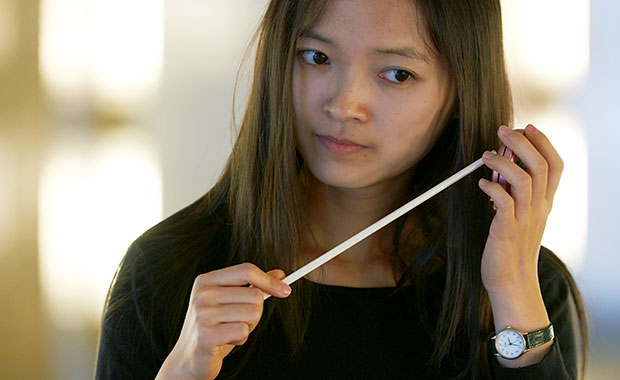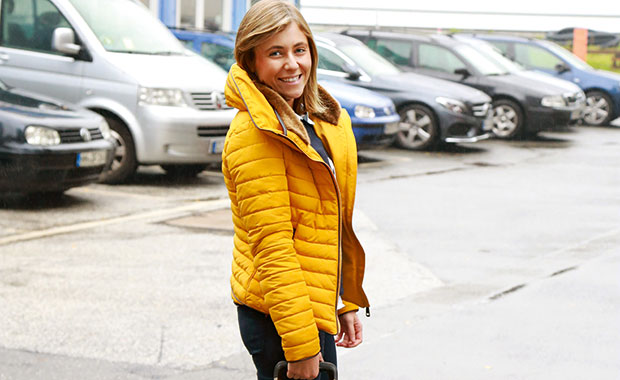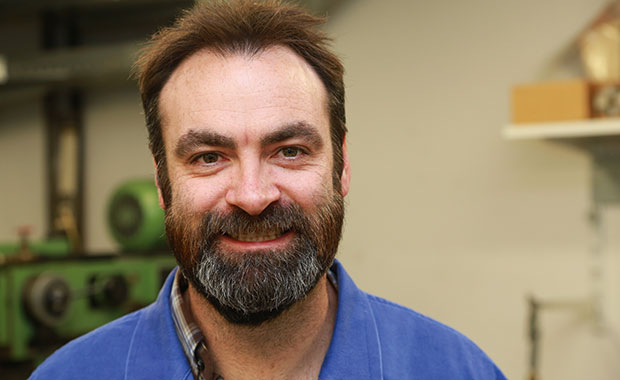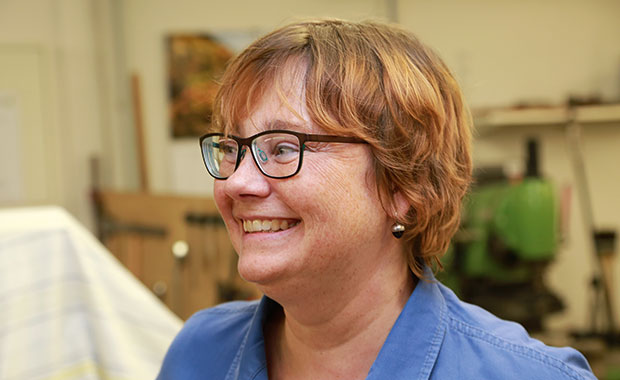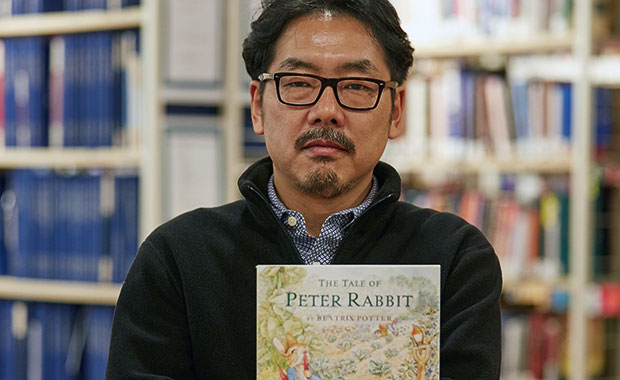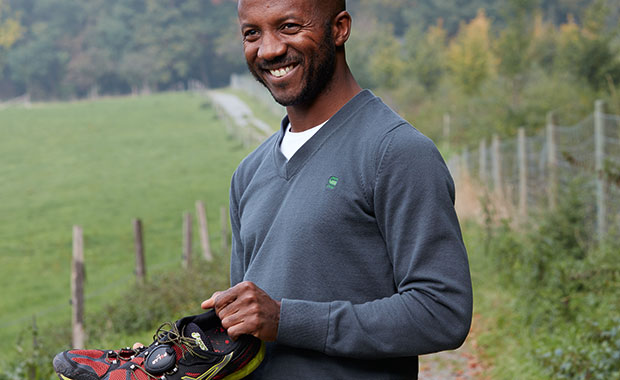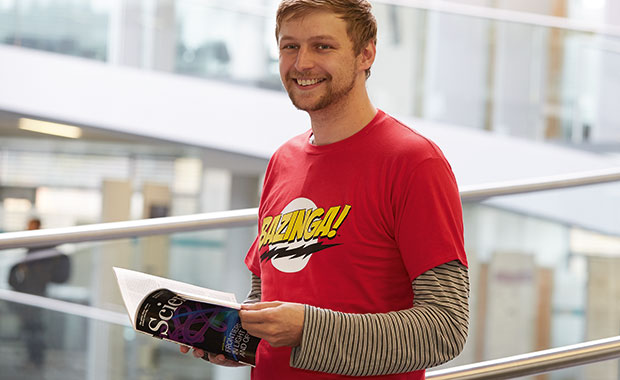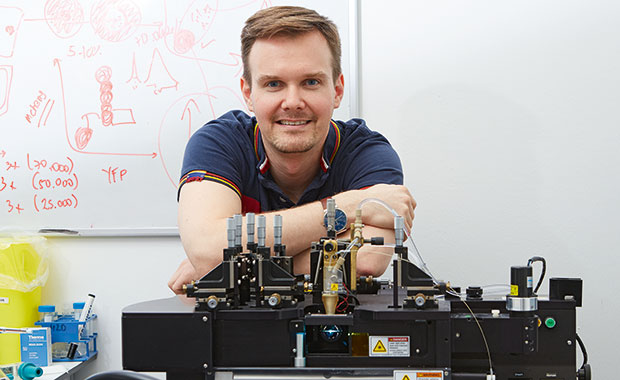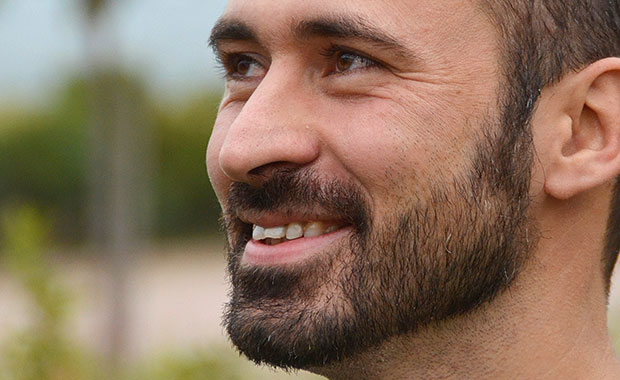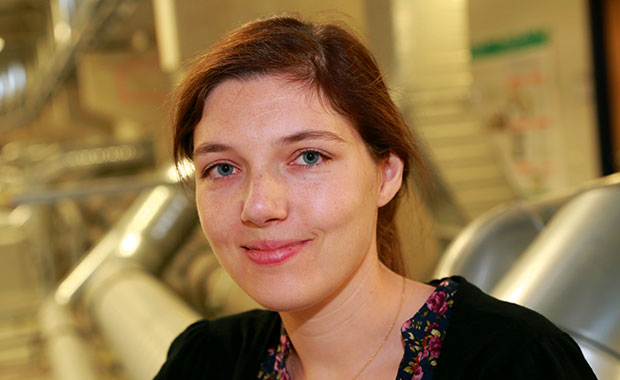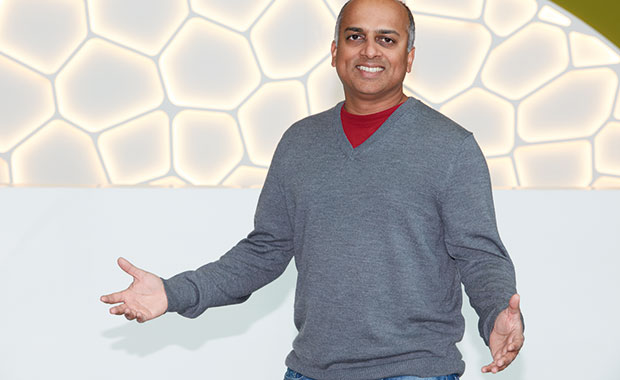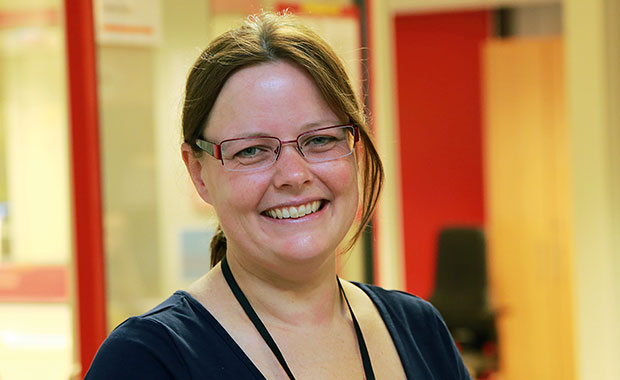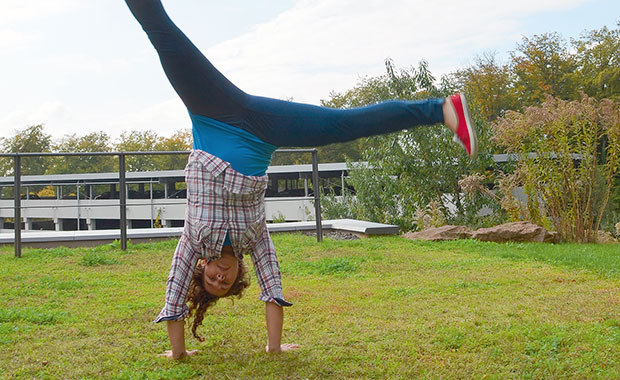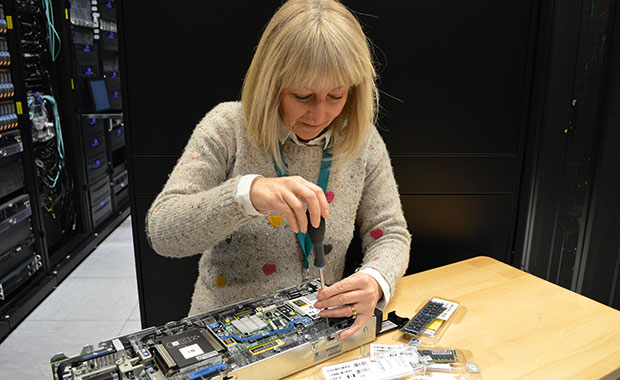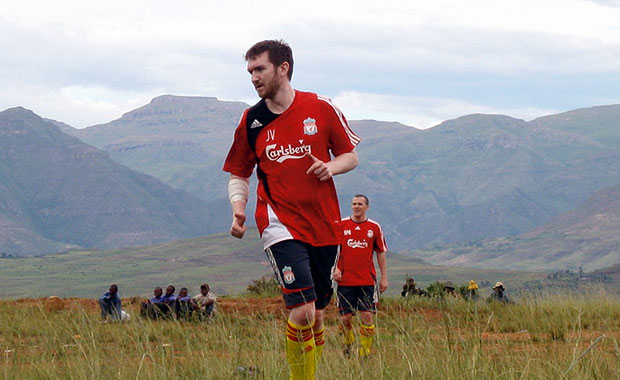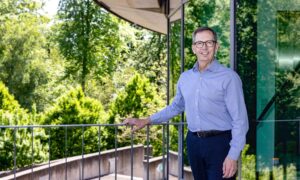
Humans of EMBL
Dive into EMBL’s universe and catch a glimpse of the lives and roles of people across the institute’s five sites.
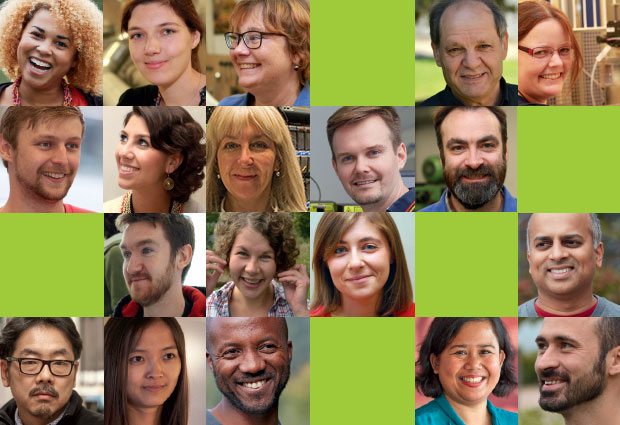
By Adam Gristwood and Rosemary Wilson
Diah Yulianti
Conference Officer, EMBL Heidelberg
“I am not a scientist by training, but I find it incredible learning how people do research, to visit their labs, and work directly with many scientists – EMBL certainly has the ‘wow!’ factor. Together, our Course and Conference Office team manages around 25 conferences and 40 courses in Heidelberg annually, and it is our role to ensure that events go well, providing aspects such as logistical support, managing speakers and delegates, and compiling abstract books. I have lived abroad for 10 years and hope to return to my home country Indonesia one day: research there is hugely underdeveloped and I hope I can bring some of the innovative, open and friendly culture at EMBL to an organisation there – either that, or try something completely different like running a sweet shop!”
I have lived abroad for 10 years and hope to return to my home country one day.
Jo Sedita
Building Manager, EMBL Grenoble
“I am celebrating a personal milestone as I joined EMBL Grenoble exactly 40 years ago in November 1975. People describe me as le homme-à-tout-faire, or the man who can do anything. I began as a beamline technician in charge of workshops before moving into building and maintenance: one major highlight was leading the extension of the Outstation’s main building in 1993. I am also frequently asked to help out with other projects such as events or even give advice on personal do-it-yourself projects. One of the best lessons I have learned over the years is that it is important to forge close relationships with people in order to get the best out of them. EMBL is my second family and I have never felt bored with what I am doing or else I would not still be here today.”
People describe me as le homme-à-tout-faire, or the man who can do anything.
Jin Wang
PhD Student, EMBL Heidelberg
“This summer, along with six other EMBLers, I took part in Roche Continents, a festival of music and drama that brings together students of arts and science to explore common grounds of creativity. I realised there are many parallels between the approaches of the two worlds: for instance, to be successful artists and scientists need to be self-critical, embrace collaboration, and give 110%. There is so much we can learn from one another as well, particularly in areas such as creative approach and communication. I also gained many other valuable insights, such as the importance of being aware of unconscious bias in our daily interactions, of adopting an open-minded approach to problems, and the benefits of taking time to have conversations and reflect on thoughts and feelings. One of the highlights was a percussion show put on by all participants, using everyday objects. I felt nervous at first, and we could not speak to each other during the performance, but I realised the importance of listening and respecting others and ourselves: when it came together, it was a beautiful moment.”
I realised the importance of listening and respecting others and ourselves.
Joana Pereira
PhD Student, EMBL Hamburg
After about 4 months into my PhD my supervisor wrote to me and another PhD student an email saying “Okinawa?” and my colleague wrote back saying “don’t you mean Chicago?”, whereby my supervisor answered “both?!” When I came for the interview here I knew I would be doing a lot of travelling and teaching during my PhD but that was the start of it all. Now I have been to Chicago three times, Japan twice, Uruguay and the UK – I love it. It’s such a great chance to get see so many different cultures and people. And it’s not only teaching, I’ve been able to see several major synchrotrons for example. Usually I am teaching people who are older than me, and often they think I am also a student when I join them in the bar! I was worried in the beginning that they wouldn’t respect me because of my age, but when I stand up to teach, they do. I really love being able to explain to others something I love. Wherever I go in the world I have to get a sticker for my suitcase. Quite often at airports people will look at me, then the suitcase, then back at me and say – ‘have you really been to all those places?’ and I will nod, and they will reply ‘wow!’”
Wherever I go in the world I have to get a sticker for my suitcase.
George Marshall
Beamline Technician, EMBL Hamburg
“I designed and manufactured a beamstop that had to be no more than 2mm in diameter: when working on such intricate projects, a major challenge is to avoid making a mistake and ending up back at the beginning. I could be drawing up a design for a new beamline component, then suddenly called to investigate a vacuum problem or to install some specialist equipment. If user operation has been interrupted due to a mechanical problem this becomes my highest priority – it can be challenging to keep on top of things, but the variety of work is hugely motivating and energising.”
The variety of work is hugely motivating and energising.
Doris Jahn
Mechanical Technician, EMBL Hamburg
“I work with people from all walks of life, and when someone comes to me with a request for components or equipment, the challenge is to understand what he or she wants to achieve with it. Our team works intensively with scientists throughout the development process and if at first our solution does not work, I adapt the blueprint and we find a way – even if it ends up looking completely different to the initial concept. I have always enjoyed creating things – I was a big fan of Lego as a child – and what I like most is being involved in the full development cycle: designing, building and testing components, as well as the international ambiance.”
If at first our solution does not work, I adapt the blueprint and we find a way.
Kota Miura
Visiting Scientist, EMBL Heidelberg
“Albert Einstein once said: “look deep into nature, and then you will understand everything better.” As a student, I went on a research expedition to a forest in Japan and realised just how important this insight was. Life science research continues to become more quantitative, with modern approaches shedding unprecedented insights into different levels and scales. However, one thing that had puzzled me was the continued application of scientific names to everything from new species, to genes and proteins, something that I associated with a ‘natural history’ approach to biology. My mentor, Haruko Kazama, taught me the importance of these names and classifications: I watched, awestruck, as she applied her rich knowledge of the natural world with convenience and clarity to identify and study animals, plants, and their molecular components. Standing in the forest, surrounded by thick vegetation, rain hammering on the canopy above, I stared intently at the plants around me: my knowledge of their names provided an entry point to apply my scientific knowledge and imagine the intricate molecular processes going on beneath. I felt a wonderful, overwhelming rush. For me, this demonstrated the power of science: you can understand the world at a level of detail few people fully appreciate. Professor Kazama had her own name for me: she likened me to Beatrix Potter’s mischievous Peter Rabbit. We still keep in touch to this day.”
She likened me to Beatrix Potter’s mischievous Peter Rabbit.
Eugene Gbekor
Senior Technical Officer/Scientist, EMBL Heidelberg
“I have just run my first marathon: it was an amazing experience, albeit not as flat as I thought it would be! I could not walk for two days after, but I am very happy as it was on my bucket list of things to do. Most of the people in our group are sports mad and it certainly creates a great atmosphere for a healthy work/life balance.”
Most people in our group are sports mad.
Piotr Krzywkowski
PhD Student, EMBL Monterotondo
“We are just beginning the PhD course – there are people with so many different areas of expertise here and it is an opportunity to learn from this, to set up potential collaborations, and to make friends. Rather than being just given a PhD project, I was asked to think of my own questions. This is one of the great things about EMBL: you shape your own path. At the beginning it was terrifying, but after burying my head in journals for two months and defining what I will work on for the next three years, I felt a great sense of accomplishment.”
Rather than being just given a PhD project, I was asked to think of my own questions.
Yvonne Yeboah
Training Lab Technician, EMBL Heidelberg
“On a perfect workday my phone keeps on ringing, as I am a problem solver at heart. We run 25 wet lab courses per year and on each occasion the training lab has to be adapted to specific needs. Recently, during a synthetic biology course, two groups designed a new experiment and needed a rare antibody: with the help of some friendly contacts downtown my colleague Jacqueline Dreyer-Lamm was able to track it down for them – that’s when you think ‘yeah, this job is great!’ I love creative, collaborative, hands-on work. With EMBL’s Arts and Crafts Club, we visit the refugee camp in Heidelberg to run sessions on jewellery and decoration making, upcycling, and more. I am worried that the refugee crisis is impossible for politicians to manage without the help of local people. I want to show the refugees a friendly, optimistic face that knows that we, as Europeans, can handle this situation.”
The refugee crisis is impossible for politicians to manage without the help of local people.
Malte Paulsen
Manager of the Flow Cytometry Core Facility, EMBL Heidelberg
“I started at EMBL three months ago: it is one of the coolest places in the world to see lots of things at the same time. I already have the feeling I am constantly missing out on great seminars or other events that take place on campus! We are providing a service to people and we work with scientists on individual experiments every step of the way, defining expectations, limitations, protecting intellectual property, and exploring what we can do together to best achieve research goals.”
It is one of the coolest places in the world to see lots of things at the same time.
Diana Mendes Freire
PhD Student, EMBL Hamburg
“Exactly two years ago I was at a microbiology conference at EMBL Heidelberg and many people were coughing and sneezing. When I got back to Hamburg I still couldn’t shift the cold, but then I also discovered a lump on my neck. At first the doctors thought it was tuberculosis but after several tests and a biopsy they told me it was lymphoma. They never said cancer. Of course there were a lot of tears, but my science background really helped me focus. I could understand what the doctors were telling me about my treatment and it was actually fascinating and calming to observe and consider what was happening in my body. My belief in God was also important for me and gave me a lot of strength. I decided to stay here in Germany for my treatment – of course it was hard to be away from home, but my mum was here for more than half a year, and the doctors were great. The EMBL environment was wonderful: people I hardly knew were there for me, and have become my second family. They understood when I needed space to recover from chemotherapy, or needed help. I think that would have been more difficult in Portugal – we would have had to barricade ourselves in the house to stop people visiting! I have always been an optimistic and upbeat person, and I believe this played a big part in my recovery. Even the doctors were amazed about how positive and calm I was throughout! I always say this was the best and the worst thing that has happened to me – it has made me stronger and changed my view on life. I want to now share some of my positive energy and have started telling my story in the hope it can help others too. For example, it I draw a black dot on a piece of white paper, all you may see is the black dot. But I realised you need to fill the white space with your dreams, colour and energy, then the black dot becomes insignificant. I also now concentrate on those things that are important to me, and try and enjoy the little things in life more. I remember the first time I was allowed outside again after one round of chemo – how wonderful it was to feel the fresh air and sunshine on my face! Sometimes we forget those little joys in life.“
Of course there were a lot of tears, but my science background really helped me focus.
Alessandro Ciccarelli
Postdoc, EMBL Monterotondo
“I have always been someone interested in many different things, such as psychology, teaching, and photography. I was also a very curious child and, to the frustration of my parents, I was always opening up toys to see how they were made inside. I found a career where I could combine all of these passions. As a scientist, I am doing psychology by studying how the brain works. I am teaching by working with students in the lab. I am doing photography by using light sheet microscopy. And I continue to be driven by my curiosity: our group is studying neural circuits underlying instinctive behaviour in mice – we have a big field of view, and are studying this at high resolution and we can almost see entire neural networks.”
To the frustration of my parents, I was always opening up toys to see how they were made inside.
Sarah Marshall
Administrative Officer, EMBL Hamburg
“When the users arrive at the User office first thing in the morning, that’s when I get my ‘to do’ list for the day. Maybe a user couldn’t find their booking for the guesthouse when they arrived at 2am the night before, or their samples didn’t get transferred to the second flight and haven’t arrived yet. That’s where I come in and chase these things up. I really love solving problems and it’s very rewarding to be able to help and be the one who can offer the information others need. I really enjoy being able to meet and talk to so many different people from across Europe and beyond. It may sound strange, but I like that I can arrange to send samples out across the world and speak to people like me in far flung places of the world and learn about their processes and procedures. Since I often have quite a lot of contact with the users by phone and email prior to their visit, it’s really interesting to meet them face-to-face for the first time. Every so often, I’m taken by surprise by someone who looks 20 years older, or even younger, than I had envisaged! It’s also fascinating seeing the difference in cultural habits when the users come too – the Russians always bring gifts with them, for example. Usually chocolate! I always feel a bit guilty about their presents and wonder what I can give them in return!“
Russians always bring gifts with them, for example. Usually chocolate!
Ramesh Pillai
Group Leader, EMBL Grenoble
“Our group is leaving EMBL and moving to the University of Geneva after nine years: I feel excited and scared in equal measure. In some respects it is like starting all over again, although I am in a much better position now. Coming to EMBL after my postdoc has been transformative because I could learn from colleagues and incorporate new aspects into my work from across the Lab’s five sites. Our group is working with gene expression, cell biology, biochemistry, and animal models – very different to most of the groups on campus in Grenoble, which is a structural biology unit. But being here, now it is so natural for me to think about structures as well and bring this component to my research – I never felt out of place! This is typical of projects at EMBL: we use multiple techniques to address a problem and it creates a great spirit that transcends traditional boundaries. Here, I have learned the power of collaborative research and it has been amazing to see the collegial spirit between peers. EMBL is not about the machines, rooms, or buildings, but about the people: you bring together talented individuals with many interests in one place and what comes out is fantastic. Like many others before me, I will also strive to carry a bit of this spirit to where I go, and try to create a little EMBL elsewhere.”
EMBL is not about the machines, rooms, or buildings, but about the people.
Melissa Graewert
EMBL Interdisciplinary Postdoc, EMBL Hamburg
“I have always said I was a bit of a “methods junkie” and here at EMBL I have realised that I am driven by my passion for a method, rather than a specific scientific question. I strongly believe in Small Angle X-ray Scattering (SAXS) as a method and what it can do for biologists and biochemists seeking to understand the bigger picture. A lot more non-specialists are relying on SAXS data now to understand their scientific question, and I really enjoy being able to support them in achieving that and developing the method based on their needs. My first contact with SAXS was as a curious, but somewhat skeptical user here in Hamburg. But it didn’t take long to convert me! I really liked the atmosphere with all these people talking and working together to run the beamline, and was immediately convinced of the benefits of the technique. So much that I jumped at the opportunity of joining the group and signed the job contract here about two months later! I really love the interdisciplinary environment here – I get to work with a great bunch of people with different backgrounds and different mindsets – engineers, physicists, software developers, biochemists and mathematicians. It’s fun to see how everyone contributes their talent and knowledge to running a great beamline. So many different disciplines in one group can of course lead to some challenges in communication. The one example we often run into is that of the ‘ideal sample’. The computer scientists want to know what the ideal sample looks like to be able to design and write the software or how to deal with the data, but as a biologist I know there is no such thing! I see part of my role as a translator, translating between the users and the computer scientists explaining what the real needs and challenges are.“
I am driven by my passion for a method, rather than a specific scientific question.
Maria Burdyniuk
PhD Student, EMBL Heidelberg
“I broke my arm this year while ice climbing, standing in the wrong place at the wrong time. I had one month without pipetting in the lab, which was frustrating, but it gave me an opportunity to step back and analyse the data I had been collecting over the past year. Now after two operations I am back climbing and doing hands-on science and it feels great.”
I had one month without pipetting in the lab, which was frustrating.
Dawn Johnson
Data Centre Engineer, EMBL-EBI
“EMBL-EBI’s data centres host one of the biggest collections of molecular data in the world, and when anything goes wrong in the campus data centre I am the first point of call. Petabytes of data are being accessed millions of times every month by users all over the world, and our job is to ensure the data and software are always available, 24/7. Last year we moved our public-facing data centre from two sites in London to a single centre in Hemel Hempstead. Our team was tasked with ensuring there was the room, electrical capacity and cables needed to make the transition successfully. There’s nothing like having to move nearly 10 000 computers to make you appreciate the sheer scale of data we store here. My father is a mechanic and an engineer: growing up I was always in the garage with him, fixing and tinkering with cars, and that was really what I wanted to do. But it was 1979 when I left school, they just didn’t hire lady mechanics. It wasn’t until a few years later when, working as a secretary for a company that sold serviced computers, my boss invited me to try my hand as a computer engineer. I was a novelty, and I still don’t meet many other women in my field, but I hope that will soon change – I’m very proud and lucky to be part of this.”
I still don’t meet many other women in my field, but I hope that will soon change.
Brendan Vaughan
Team Leader, Web Development, EMBL-EBI
“Next week I am travelling to Lesotho during my vacation time to work with Kick4Life, a football initiative that aims to better the lives of vulnerable young people in the country. Over the years I have taken part in various sporting challenges to raise money for Kick4Life, which promotes sustainable livelihoods, health education, HIV testing and counselling. HIV testing can be a deeply stressful and distressing experience, and the charity is doing amazing work providing a setting that fits naturally in the community and engages people who might otherwise slip through the health-clinic net. In a country with the second highest HIV prevalence in the world, identifying undiagnosed HIV is crucial to winning the battle against the continued spread of the disease. justgiving.com/Brendan-Vaughan“
I have taken part in various sporting challenges to raise money for Kick4Life.
